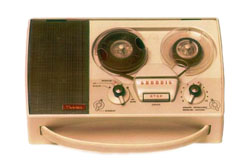There’s never been a better time to take up ear training. More than ever before, it’s possible to train your ears when you’re on the go – giving you one less excuse for not practicing, and helping develop your ears even faster. Now you can use those 5 minutes at the bus stop or 20 minutes stuck on a train to push your ear training forward another notch.

In a previous post, “Ear training all the time” I talked about the importance of regular practice when trying to develop your ears. The suggestions in that post are mostly based around active listening. An important skill, but it makes for quite passive training: because you’re grabbing ear training opportunities wherever you hear them, there’s not generally any feedback on whether your judgements are right or wrong. Nowadays though, this needn’t be the case.
Okay, you can’t lug a Steinway around with you at all times, but you can grab an app for your iPhone that lets you check pitches and intervals at any moment. You may not have a mixing desk with you for checking audio band judgements, but you can load up some band-limited pink noise onto your MP3 player and check your memory of what each band sounds like. When you think you’ve figured out that drum beat you just heard on the radio and have the urge to rush home to your drumkit, you can pull out the electronic drumkit toy on your keyring or record a snippet of the track on your phone to check when you get home.
Here at Easy Ear Training we’re hugely excited about the power and efficiency technology can bring to ear training. We’re just beginning to discover the ways we can learn more effectively using technology, and the incredible variety of amazing electronic musical and audio gizmos is just making it easier and easier to train wherever you are.
In this post I want to focus on a particular gadget that can be your best friend when you’re developing your ears: your phone. It’s something that almost everyone carries around in their pocket these days, and most phones now offer a huge number of possibilities for helping the ear training student when they’re out in the world.
CNET news piece on mobile phone orchestras
Ear training on your phone
In the last few years, the mobile phone has moved from being just a portable telephone to also acting as a computer, a diary, a games console, an internet tablet, a social network client… and even an instrument! More than 90% of Americans have a cell phone[ref], and more than half of them have apps installed[ref]. These powerful devices are increasingly ubiquitous and versatile. So how can we make the most of them for ear training?
Here are 5 suggestions for using your phone to help your ear training – so you can train, wherever you are:
1. Turn your phone into an instrument
There’s no shortage of great apps to let you ‘play’ your phone. Pianos, as always, are prevalent! Here are some apps for iPhone, Blackberry, and other phones (visit GetJar.com to find out which apps will work with your handset).
- Virtuoso Piano Pro Classic – Excellent piano app (iPhone)
- DigiDrummer – Great for figuring out the drum parts you hear (iPhone)
- Simple Songwriter – Handy for quickly trying out chord progressions (iPhone)
- Musical – Very versatile keyboard instrument (Android)
- xPiano – Multi-touch piano (Android)
- BlackBeats – Simple piano and drumkit at your fingertips (BlackBerry)
- Venabili Metronome – Versatile metronome app (other)
- PianoWork – Touch-sensitive piano (other)
- JPianinho – Simple piano note player (other)
Have a suggestion for one we’ve missed out? Let us know in the comments!
Tip: Add the app to your home screen if possible, so you have instant access.
Now use your new instrument to check notes, intervals, chords, octaves and more when you’re on the go.
Smule's popular Ocarina app for the iPhone - use it to try out melodies
2. Save example sound clips on your phone
If you can’t find the right app or your phone doesn’t support them – try using sound clips instead. Put some labelled MP3 or WAV files onto your phone to use as reference: notes, chords, chord progressions, audio bands… you name it! Here are a few suggested sound packs to get you started:
- iBeat Piano packs
- Distorted Guitar pack
- Acoustic Guitar pack 1 and pack 2 and another one
- Metronome at various rates
You can explore sites like Freesound, SampleSwap and the OLPC sound sample library to find more.
This way even if you don’t have a suitable app, you can check what you hear against labelled sound clips and find out if you were right.
3. Record sounds you don’t recognise or understand
 Most every phone now has some kind of sound recording app built-in. Whenever you hear something and try to make sense of it (intervals, chords, chord progressions, audio effects – anything!) whip out your phone and record a quick clip. The ability to do this at a moment’s notice is an incredible benefit for ear training students! You can then listen to the sound clip at your leisure, and continue trying to hear what’s going on. Failing that, you can try to analyse or recreate it using your tools at home. If you still can’t figure it out, post it online (in our forums, for example) and ask for help!
Most every phone now has some kind of sound recording app built-in. Whenever you hear something and try to make sense of it (intervals, chords, chord progressions, audio effects – anything!) whip out your phone and record a quick clip. The ability to do this at a moment’s notice is an incredible benefit for ear training students! You can then listen to the sound clip at your leisure, and continue trying to hear what’s going on. Failing that, you can try to analyse or recreate it using your tools at home. If you still can’t figure it out, post it online (in our forums, for example) and ask for help!
It takes a bit of confidence to get out your phone and record something, but you’ll learn a huge amount this way and it’s a really great way to start bringing your “clean room” talents out into the real world.
4. Active listening practice
Most phones nowadays also serve as MP3 players. Throw some interesting music onto your phone, and next time you’re stuck, bored, on a journey, or waiting for something, plug in your earphones and listen. Don’t just have music on in the background – listen. If you mind starts to wander – stop it, and focus on listening to the music.
Check out our Open Your Ears series for some ideas of interesting music to practice active listening with.
5. Download a dedicated ear training app for your phone
There are phone apps to help with most aspects of ear training – and no doubt the rest are on their way! Here at Easy Ear Training we’ve got several more in the pipeline. There are also lots of apps which you can use to just check what you think you’re hearing. Here are some suggestions:
- Our own apps (of course!) RelativePitch and Step and a Half (iPhone).
- PocketRTA – Check frequency content of sounds (iPhone)
- Chirp! – Learn to recognise birdsong: a great way to stretch your ears in a new direction (iPhone)
- Metronome – Quickly check tempos, or figure out rhythms (BlackBerry)
- Musical Ears – An ear training game to help you transcribe (Android)
- TapTheBeat A metronome app for checking tempos (other)
- Guitar ChordGenie – Easily check what you hear against a database of guitar chords (other)
Phone apps are the exciting new way to develop your musicianship even when you’re not at your instrument. Next time you’re looking at phone apps, try buying an ear training or music education app instead of the latest gimmick or game!
Don’t fall behind on your ear training because you can’t find the time, or it doesn’t seem convenient. Try out some of the suggestions above to bring your aural development into everyday life – wherever you may be!
Got a great idea for ear training with your phone? Tell us in the comments below!






